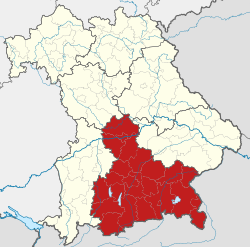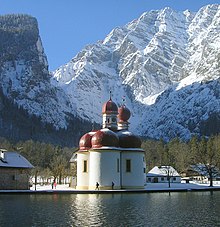Upper Bavaria
Upper Bavaria
Oberbayern (German) | |
|---|---|
 Map of Bavaria highlighting Upper Bavaria | |
| Country | Germany |
| State | Bavaria |
| Region seat | Munich |
| Government | |
| • District President | Konrad Schober |
| Area | |
• Total | 17,529.41 km2 (6,768.14 sq mi) |
| Population (31 December 2023)[1] | |
• Total | 4,820,938 |
| • Density | 280/km2 (710/sq mi) |
| GDP | |
| • Total | €320.025 billion (2022) |
| Website | regierung.oberbayern.bayern.de |
Upper Bavaria (German: Oberbayern, pronounced [ˈoːbɐˌbaɪ̯ɐn] ; Bavarian: Oberbayern) is one of the seven administrative regions of Bavaria, Germany.
Geography
[edit]Upper Bavaria is located in the southern portion of Bavaria, and is centered on the city of Munich, both state capital and seat of the district government. Because of this, it is by far the most populous administrative division in Bavaria. It is subdivided into four planning regions (Planungsverband): Ingolstadt, Munich, Bayerisches Oberland (Bavarian Highland), and Südostoberbayern (South East Upper Bavaria). The name 'Upper Bavaria' refers to the relative position on the Danube and its tributaries: downstream, Upper Bavaria is followed by Lower Bavaria, then Upper Austria, and subsequently Lower Austria. It consists of 20 districts and 500 municipalities (including three cities).
Landkreise (districts):
- Altötting
- Bad Tölz-Wolfratshausen
- Berchtesgadener Land
- Dachau
- Ebersberg
- Eichstätt
- Erding
- Freising
- Fürstenfeldbruck
- Garmisch-Partenkirchen
- Landsberg
- Miesbach
- Mühldorf
- Munich (München)
- Neuburg-Schrobenhausen
- Pfaffenhofen
- Rosenheim
- Starnberg
- Traunstein
- Weilheim-Schongau
Kreisfreie Städte (district-free cities):
- Ingolstadt
- Munich (München)
- Rosenheim
Population
[edit]Historical Population of Upper Bavaria:
| Year | Inhabitants |
|---|---|
| 1840 | 711,861 |
| 1871 | 865,178 |
| 1900 | 1,351,086 |
| 1925 | 1,727,483 |
| 1939 | 1,999,048 |
| 1950 | 2,541,896 |
| 1960 | 2,844,910 |
| 1970 | 3,372,700 |
| 1980 | 3,657,776 |
| 1990 | 3,801,448 |
| 2000 | 4,083,077 |
| 2010 | 4,373,588 |
| 2015 | 4,588,944 |
| 2019 | 4,710,865 |
Economy
[edit]The Gross domestic product (GDP) of the region was 273.7 billion € in 2018, accounting for 8.2% of German economic output. GDP per capita adjusted for purchasing power was 53,900 € or 179% of the EU27 average in the same year. The GDP per employee was 134% of the EU average. This makes Upper Bavaria one of the richest regions in Europe.[3]
History
[edit]The duchy of Upper Bavaria was created for the first time with the First Bavarian partition in 1255 under duke Louis II, but there was no exact correlation between this duchy and the current territory. After the reunification in 1340 Bavaria was divided again in 1349, and in 1392 the duchies Bavaria-Munich and Bavaria-Ingolstadt were created in Upper Bavaria. In 1505 Bavaria was permanently reunited. For administrative purposes, Bavaria was split into Rentämter (plural of Rentamt). Upper Bavaria consisted of the Rentamt Munich and Rentamt Burghausen.
After the founding of the Kingdom of Bavaria the state was totally reorganised and, in 1808, divided into 15 administrative districts (Regierungsbezirke (singular Regierungsbezirk)), in Bavaria called (Kreise (singular Kreis)). They were created in the fashion of the French departements, quite even in size and population, and named after their main rivers. In the following years, due to territorial changes (e. g. loss of Tyrol, addition of the Palatinate), the number of districts was reduced to 8. One of these was the Isarkreis (Isar District). In 1837 king Ludwig I of Bavaria renamed the Kreise after historical names, and tribes. This also involved border changes or territorial swaps. Thus, the Isarkreis changed to Upper Bavaria.
Instead of a Rentamt-style mere administrational unit, the newly created districts became predecessors of modern regional self-government, building a political and administrational link in-between the Bavarian state as a whole and the local authorities.
Main sights
[edit]


Featured former residence cities are the capital Munich, Ingolstadt and Neuburg an der Donau and the diocesan towns of Freising and Eichstätt. Interesting townscapes are found at Landsberg am Lech, Wasserburg am Inn and Burghausen and further south Bad Reichenhall and Berchtesgaden.
The highest mountain in Upper Bavaria, Zugspitze, offers an incomparable panoramic view of the Alps. Nestled in forested mountain ranges, the lakes Tegernsee, Schliersee, and Spitzingsee, are idyllically situated. The larger lakes, like Starnberger See, Ammersee (south-west of Munich), and Chiemsee further to the east, all situated in the pre-alpine uplands, offer regular Passenger services on steamers.
Sacred art treasures can be found in the monasteries Andechs, Schäftlarn, Fürstenfeld, Benediktbeuern, Polling and Ettal and in the Wieskirche. Among popular excursions in Upper Bavaria are the Koenigssee with the Sanctuary of St Bartholomew's and mount Watzmann, the royal castles of Ludwig II, Linderhof and Herrenchiemsee in Chiemsee, the Burghausen Castle and the castle Hohenaschau. The most important places of pilgrimage are Altoetting and Tuntenhausen.
References
[edit]- ^ Genesis Online-Datenbank des Bayerischen Landesamtes für Statistik Tabelle 12411-003r Fortschreibung des Bevölkerungsstandes: Gemeinden, Stichtag (Einwohnerzahlen auf Grundlage des Zensus 2011).
- ^ "EU regions by GDP, Eurostat". Retrieved 18 September 2023.
- ^ "Regional GDP per capita ranged from 30% to 263% of the EU average in 2018". Eurostat.
External links
[edit]![]() Media related to Upper Bavaria at Wikimedia Commons
Media related to Upper Bavaria at Wikimedia Commons
- Official website Regierung von Oberbayern (in English and German)
- Official website Bezirk Oberbayern (in German)
- Tourism website (in English and German)

